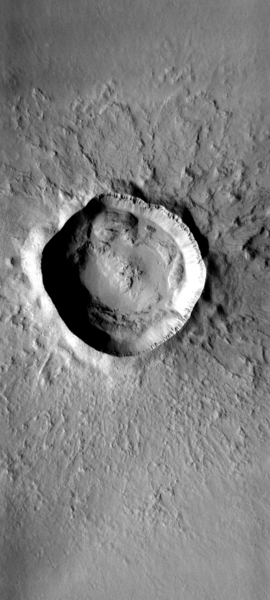11. Source of Mars meteorites found?
A young Martian crater named Zunil may be the source for some meteorites that have come from Mars.
A few million years ago or less, a meteorite struck Mars' Cerberus Plains and blasted a crater named Zunil, 10 kilometers (6 miles) wide. Cerberus is home to the youngest (least cratered) large lava plain on Mars. The impact that made Zunil spewed enough debris fragments to gouge an estimated 10 million secondary craters bigger than 10 meters (33 feet) wide.
Many of Zunil's secondaries concentrate in radial streaks that reach as far as 1,600 km (1,000 miles), in a pattern echoing lunar craters like Tycho. Most larger Zunil secondaries are distinctive in both visible and thermal infrared imaging by THEMIS. Mars Global Surveyor MOC images of them show sharp rims and bright ejecta and rays. But the craters are shallow and often noncircular, as expected for impacts that land at relatively low velocities.
Scientists have long used the number of small craters to estimate ages of surfaces - the more craters, the older the surface. If Zunil was a representative large impact for Mars, then secondary craters should be vastly more abundant than primaries in the smaller sizes. As a result, most small craters on Mars - those less than 1 km (half a mile) across - could be secondaries, and martian terrains dated by counting small craters could be older than recent estimates have thought.
Zunil's youthful age and far-flung debris pattern also offer a possible answer to the source of the martian meteorites known as shergottites. These meteorites formed as part of one or more basalt flows that cooled in place on Mars 165 to 177 million years ago. Two populations of shergottites exist, one that was ejected from Mars 1.5 million years ago, the other 2.7 million years ago.
Did the Zunil impact send shergottite meteorites toward Earth? The uppermost Cerberus Plains appear about 100 million years old, but older layers probably lie below. And Zunil's impact date could fit either the 1.5 or the 2.7 million year ejection age.
Other News & Discoveries

Hit Hard
Zunil is a geologically fresh crater that sent fragments flying at least 1,600 kilometers (1,000 miles). The impact making the 10 km (6 mile) crater may even have shot some fragments to Earth. This is a portion of THEMIS visual image V09818024.
(NASA/JPL-Caltech/Arizona State University)
Download Original